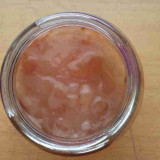Fermented foods are an important part of a balanced diet, especially for raw food and plant-based diets. With the recent discovery of the integral role of our intestinal microbiome in health and wellbeing, there is a rising interest returning to many of the traditional food preparation methods. In particular, culturing allows beneficial bacteria to predigest raw foods making nutrients significantly more bioavailable.

The first time I experimented with raw foods I did not even consider trying cultured foods. Not that I wasn’t already consuming some (miso paste and yogurt), but I had no intention of making more work for myself. Or so I thought.
I have known about the importance of probiotics for quite some time. (I even take a supplement daily). But other than my plain greek yogurt and miso, I had not really ever tried fermented food.
Because I had digestive issues, I decided to try fermented foods. In the first week of Ani Phyo’s Raw Food Detox, she recommends sauerkraut in a few salads. The first few days I just skipped it in my meals. Then I accidentally bought a huge amount of cabbage and bok choy (chinese cabbage) at the same time. Thus began my first homemade batch of sauerkraut.
If you have eaten sauerkraut from the supermarket and were not been impressed (or even if you were) you are in for a treat. Homemade sauerkraut is green, sweet, and tangy, nothing like the stuff in the store. All it takes is cabbage, salt, a sanitized jar and 4 days.
You can put a few tablespoons on anything. Salads and sandwiches are my favorite.
Fermented foods are “the flavorful space between fresh and rotten.”
Sandor Katz, The Art of Fermentation.
Fermented foods have been an important part of the history of our relationship to food. Hunter/gatherers quickly found that finding ways to preserve their food was critical for the survival of their families and communities. Historians speculate that our ancestors first discovered fermenting fruit on the forest floor, tried it, survived and enjoyed it. The rest, as they say, is history.
We are all familiar with some cultured foods, beer, wine, and pickles are probably most well known. Most of us have also tried yogurts, vinegars, olives, and cheeses. Essentially, fermented foods are raw foods that are transformed by the activity of microorganisms in an oxygen free environment, converting complex carbohydrates to simpler molecules and an acidic or alcoholic solution. The acid and alcohols act as preservatives extending the shelf life of the food.
The resulting food has a greater depth and complexity of flavor. Researchers have shown that fermentation helps to release additional nutrients as well as creates even more nutrients as by-products of the process.
Lactobacilli cultures are used to convert sugars and starches into lactic acid. This is the most used process for food fermentation, as it preserves and enhances the texture and taste of foods.
This is the method that creates sour ferments including sourdough and vinegars.
This is primarily used for brewing alcoholic beverages. Yeast cultures convert starches into alcohol and CO2.

For live cultures look for lacto-fermented or make your own.

Look for living cultures. Homemade is easy using a starter culture.

Homemade is easy and the taste is incomparable.

Kombucha requires a SCOBY (symbiotic colony of bacteria and yeasts).

This Korean staple is a spicy cabbage based dish.

Soybean based miso has a variety of uses, imparting umami flavor.

In India this milky beverage is a meal accompaniment.

Cooking destroys the live cultures, however the bread is more digestible.
Cutting-edge research is uncovering the important connection between our intestinal health and our overall health. Our gut microbiome contains around 40 trillion microorganisms (bacteria and yeasts primarily) that live with us in a symbiotic relationship. These beneficial microbes, also known as probiotics, digest the foods that were unable to be digested in the stomach and small intestine in a process of fermentation. They play an important role in the synthesis of vitamins and minerals, enzymatic activity, the
production of essential fatty acids, and the breakdown antinutrients.
We now know that a very large proportion (likely over 70%) of our immune system is in our gut. The microbes in our intestines are an integral part of the immune process. Scientist are just beginning to uncover the mechanism by which lacto-fermented foods seem to activate immune cells. Cultured foods support the probiotic ecosystem that protects the intestinal walls and send signals to the lymph system to control invaders.
Raw plants have substances called antinutrients that interfere with the absorption of essential nutrients. Fermented foods have the benefit of being pre-digested by bacteria, reducing the effects of the antinutrients. Lectins (in grains and beans), oxalates (in greens), phytates (in nuts, seed, grains and legumes), and glucosinolates (in cruciferous vegetables) are reduced by fermenting. Additionally, beneficial bacteria love fiber, another part of plants that is difficult on the digestive tract.
Learning to embrace cultured foods is an important part of a balanced raw diet. Without the benefit of fermenting, the variety of foods that can be eaten is limited. In addition, research indicates that there are benefits of consuming living probiotic cultures. Fermenting even increases the nutritional value of most foods and enhances enzyme activity.
Fermentation has the most profound impact on the digestibility of grains and other starches. The surfaces of grains and plants contain anti-nutrients, which are protective chemicals intended to discourage animals from eating the plants. In addition, the fiber in raw plants can also be extremely difficult to digest. The bacteria in the fermentation process transform the antinutrients and fiber making the nutrients in the plant more available to the human digestive tract.
Other plant foods benefit from lacto-fermentation. Cruciferous vegetables (cauliflower, broccoli and cabbage) are much less fibrous after culturing. So are hard leafy greens.
Discovering the world of fermented foods is exciting! My earliest experiments were successful. I tried Kimchi in a pint jar. It was so spicy and delicious. My next project was this Fermented Salsa Starter which I made in a 2-quart jar. Every time I make salsa or guacamole, I just add a few tablespoons to the fresh vegetables and fruit (yes, I make fruit salsas). The depth of flavor is out of this world. Sourdough was also on the list with varying success. While my waffle and pancake recipes were consistent winners, making loaf bread was a little more of a hit or miss situation.
More recently, I have tried kombucha, jun tea, milk kefir, and water kefir. Of those water kefir is my favorite. It is like low sugar soda with major probiotic benefits (researchers estimate that water kefir contains over 50 probiotics strains, just slightly lower than milk kefir). Like kombucha, flavorings can be added in a second fermentation. My sourdough bread experiments continue. I cannot say that I have a foolproof recipe but I am enjoying the experimentation.
I have seen recipes for other vegetables, chutneys, natto, rejuvelac, and many more. I have only ventured into fermenting with brine but there are many other methods and foods.
As the summer harvest comes in I am always looking for ways to preserve those foods and flavors. Fermenting is my go to option. Although lacto-fermentation is easy, it does require a few things. First, filtered water must be used, chlorine will kill the bacterial culture. I prefer a mineral salt like Celtic sea salt or Himalayan salt, however, any salt except Iodized salt and salt with anti-caking ingredients can be used (iodine kills the culture). You will also need sterile glass jars and lids for the on the counter fermentation and storage in the refrigerator. Flip top bottles are key to creating a fizzy kombucha or kefir with a second fermentation.
As for specific tools, I got the Perfect Pickler fermenting system as a gift. It is by no means necessary to ferment fruits and vegetables but it makes it easier and ensures that the produce does not spoil. Fermenting is an anaerobic process so the lid prevents airborne bacteria from getting into the food. Most recently I purchased The Easy Fermenter lids, a less complicated and easier to store lid. The top is designed to allow gasses to escape without opening the lid.
Research is in its infancy and the specific details of how to use fermented foods for medicinal purposes is far from conclusive, however, there is little doubt that adding fermented foods to your diet in moderate amounts is likely to have some benefit without presenting a significant health risk.
Frequently asked questions about fermented foods.
Generally speaking yes. Fermentation creates lactic acid as a by product that preserves foods and extends shelf life, keeping toxic microbes at bay. There is a small risk of contamination if the fermented food is exposed to air before the culture has a chance to develop.
In fact, in many instances eating fermented foods are safer than eating the raw version. Uncooked produce can carry unsafe organisms if not cleaned well.
Yes, some commercially produced fermented foods have beneficial bacteria. Read the labels very carefully. However, home made cultured foods tend to have a more diverse community of microorganisms. And nothing tastes better than homemade food.
Sandor Ellix Katz
May 14 2012
Şanlier N, Gökcen BB, Sezgin AC.
Health benefits of fermented foods.
Oct 20 2017
Kelly Bilodeau, Harvard Health Publishing, Harvard Medical School
Fermented foods for better gut health
May 16 2018
https://www.health.harvard.edu/blog/fermented-foods-for-better-gut-health-2018051613841
Michael O, Schroeder, U.S. News and World Report
Are Fermented Foods Good For Digestive Health?
May 14 2019
https://health.usnews.com/wellness/food/articles/are-fermented-foods-good-for-digestive-health
PLOS Genetics
Bacteria in fermented food signal the human immune system, explaining health benefits
May 23 2019
https://www.sciencedaily.com/releases/2019/05/190523142201.htm
© 2023 Fiber of Life LLC All Rights Reserved.

Disclaimer The information on this website is NOT medical advice. It is not intended to diagnose, treat, cure, or prevent any disease. Before making any changes please seek advice from a medical professional.
A new chapter is calling.
Women Don’t Retire: How to Live Your Passion and Leave Your Legacy is a soulful guide for women of color navigating life after leadership. Whether you’re stepping away from your career—or stepping deeper into your purpose—this book offers stories, reflections, and wisdom to help you align with what’s next.
Ready to redefine what “retirement” looks like?


